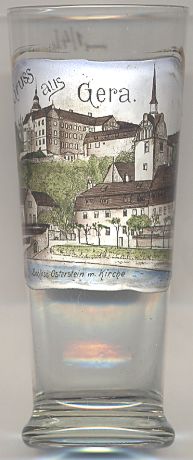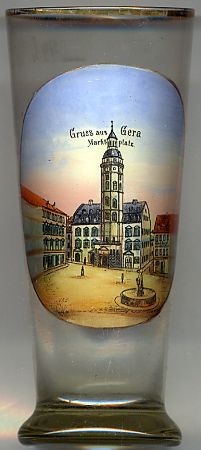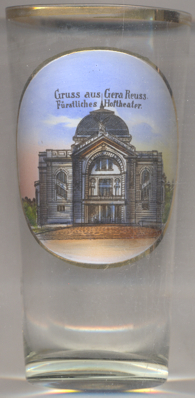

|
| DEUTSCHLAND | GERMANY |
| Bundesland: Freistaat Thüringen | Thuringia |
| Stadt: Gera |
Gera is situated at an elevation of 205 m on the river Weiße Elster in the east Thuringian hills. After Erfurt and Jena it is the third-largest city in Thuringia. The city has a population of about 100,600 (2008).
The place name Gera originally referred to the area of the Elster river valley where the city later stood. The name likely originated before the European migration period, and the Slavic people who first settled the area during the 8th century adopted it. The first known documentary mention of Gera dates from 995. In 999, Emperor Otto III assigned the "province" of Gera to the Quedlinburg Abbey, whose abbesses assigned the protectorship of this area in 1209 to the bailiffs of Weida who served as its administrators. After a time as a settlement where the city center now stands, Gera acquired the rights of a city in the 13th century. At first it grew only slowly. In 1450, it was almost totally destroyed during the Saxon Fratricidal War. Through inheritance over the next centuries, Gera became part of the Reuß (Reuss) principalities (see maps of the Thuringian principalities in 1815, 1826 and 1848. At 1806, in one of the stages of the War of the Fourth Coalition, Napoleon placed his Imperial Headquarters at Gera. From there on October 12, 1806, the French Emperor addressed an arrogant and threatening letter to King Friedrich Wilhelm III of Prussia, which directly led to war and to the crushing defeat of Prussia at the Battle of Jena a few days later. From 1848 to 1918 Gera served as the capital of the Reuß Junior Line principality. With the industrial revolution in the middle of the 19th century, Gera enjoyed rapid growth through its textile industry. The city also became a railway center where many rail lines met. In 1920 the city became part of the newly founded state of Thuringia. Aerial bombing destroyed some parts of the city in 1945. The city became a part of the newly created District of Gera in 1952 within the German Democratic Republic. After the fall of the iron curtain in 1990 and the German reunification, Gera became part of the restored state of Thuringia – one of three metropolitan centers along with Erfurt and Jena. [Text adapted from http://en.wikipedia.org/wiki/Gera]

 Osterstein castle [top left] was the residential castle of the principality of Reuß Junior Line.
The first castle had been build by the bailiffs of Weida in the 12th century. The impressive castle keep is still remains from this construction.
As this castle was located on the left bank of the river it did not belong to the possessions of the Quedlinburg abbey but to those of the landgraves
of Thuringia. When the castle of the bailiffs of Gera was destroyed in 1450 during the Saxon Fraticidal War, the lords of Gera moved there seat to
this place. When their family became extinct in 1550, the area came in possession of their relatives, the Reuß of Plauen zu
Greiz. During the 16th and 17th centuries, the castle was gradually transformed into a Renaissance residential palace.
Its name, Osterstein, was first mentioned in 1581. The castle was the residence of the princes of Reuß-Gera until their becoming extinct in 1802.
In 1848, after the princes of Reuß-Schleiz had obtained the governance of Reuß-Ebersdorf and Reuß-Lobenstein,
Gera became the official residence of the principality Reuß Junior Line. On 1 March 1908 Osterstein castle was the site of the marriage of
the Bulgarian Czar Ferdinand I with princess Eleonore of Reuß-Köstritz (the ceremony followed the Protestant rite; the pair had already been
married two days before in a Catholic ceremony held at Coburg as Ferdinand belonged to the Catholic line Saxe-Coburg-Koháry).
After the end of the monarchy in 1918, the castle remained the
residence of the princely family. During World War II, on 6 April 1945, the castle was largely destroyed during bomb raid of Allied air forces.
Only the only castle keep remained; the remaining ruins were torn down in 1962 and a restaurant was built in their place.
[Text adapted from https://de.wikipedia.org/wiki/Schloss_Osterstein_(Gera)]
Osterstein castle [top left] was the residential castle of the principality of Reuß Junior Line.
The first castle had been build by the bailiffs of Weida in the 12th century. The impressive castle keep is still remains from this construction.
As this castle was located on the left bank of the river it did not belong to the possessions of the Quedlinburg abbey but to those of the landgraves
of Thuringia. When the castle of the bailiffs of Gera was destroyed in 1450 during the Saxon Fraticidal War, the lords of Gera moved there seat to
this place. When their family became extinct in 1550, the area came in possession of their relatives, the Reuß of Plauen zu
Greiz. During the 16th and 17th centuries, the castle was gradually transformed into a Renaissance residential palace.
Its name, Osterstein, was first mentioned in 1581. The castle was the residence of the princes of Reuß-Gera until their becoming extinct in 1802.
In 1848, after the princes of Reuß-Schleiz had obtained the governance of Reuß-Ebersdorf and Reuß-Lobenstein,
Gera became the official residence of the principality Reuß Junior Line. On 1 March 1908 Osterstein castle was the site of the marriage of
the Bulgarian Czar Ferdinand I with princess Eleonore of Reuß-Köstritz (the ceremony followed the Protestant rite; the pair had already been
married two days before in a Catholic ceremony held at Coburg as Ferdinand belonged to the Catholic line Saxe-Coburg-Koháry).
After the end of the monarchy in 1918, the castle remained the
residence of the princely family. During World War II, on 6 April 1945, the castle was largely destroyed during bomb raid of Allied air forces.
Only the only castle keep remained; the remaining ruins were torn down in 1962 and a restaurant was built in their place.
[Text adapted from https://de.wikipedia.org/wiki/Schloss_Osterstein_(Gera)]
The  Marienkirche (Church of Our Lady) [bottom right] is located in the Untermhaus district of Gera.
The church was built in 1440 in late Gothic style in place of an older church which probably had been built already in 1193.
Until 1736 the church was a filial church of the parish of Gera. Between 1802 and 1854 it also served as the church of the garrison of the Reuß military.
In 1882 the church was enlarged and two small towers in Gothic revival style were added to the western façade.
[Text adapted from https://de.wikipedia.org/wiki/Marienkirche_(Gera)]
Marienkirche (Church of Our Lady) [bottom right] is located in the Untermhaus district of Gera.
The church was built in 1440 in late Gothic style in place of an older church which probably had been built already in 1193.
Until 1736 the church was a filial church of the parish of Gera. Between 1802 and 1854 it also served as the church of the garrison of the Reuß military.
In 1882 the church was enlarged and two small towers in Gothic revival style were added to the western façade.
[Text adapted from https://de.wikipedia.org/wiki/Marienkirche_(Gera)]
The famous painter Otto Dix (1891–1969) was born in Gera. The house where he was born, next to the church of Our Lady, was converted to a museum in 1991.

The  Town Hall [near left] was built in 1573–1575 in Renaissance style. It replaced an earlier building
which dated from 1487 and itself had replaced the first town hall which was first mentioned in 1425 and had been destroyed in 1450.
As the Renaissance town hall shows striking similarities to the town hall of Altenburg it is assumed that the two building were
designed by the same master builder, Nicol Gromann from Torgau. During the large fire of 1780 most of the building burnt out, but its walls were preserved
so that it could be rebuilt in 1783/1784 following the original design. Ten years later, in 1793, an additional wing was added on its back side.
A further wing, the "New Town Hall" was added in 1911/1912.
Town Hall [near left] was built in 1573–1575 in Renaissance style. It replaced an earlier building
which dated from 1487 and itself had replaced the first town hall which was first mentioned in 1425 and had been destroyed in 1450.
As the Renaissance town hall shows striking similarities to the town hall of Altenburg it is assumed that the two building were
designed by the same master builder, Nicol Gromann from Torgau. During the large fire of 1780 most of the building burnt out, but its walls were preserved
so that it could be rebuilt in 1783/1784 following the original design. Ten years later, in 1793, an additional wing was added on its back side.
A further wing, the "New Town Hall" was added in 1911/1912.

The  municipal theatre [near left] was built in 1900–1902 as the
Princely Court Theatre (Fürstliches Hoftheater). The architect was Heinrich Seeling. the construction
was funded by lottery funds as well as by donations by the princely family. The theatre replaced an older theatre building
that was originally built in the 1820s and was rebuilt in 1870–1871. After the dissolution of the monarchy, the
theatre was renamed Reußisches Theater in 1918. It was extended in 1922 by a storage building. Closed in
1944, it reopened in September 1945 as Stadttheater (Municipal Theatre). The complex includes a theatre
(670 seats) and a concert hall (960 seats). The stagehouse was damaged by a fire in 1963 and was subsequently
rebuilt and modernised. A new organ was installed in the concert hall in 1977. In 2005–2007 major exterior and
interior restorations were made. It is used as one of the two main venues of the "Theater & Philharmonie Thüringen"
opera and drama companies (the other one is the state theatre in Altenburg).
[http://www.andreas-praefcke.de/carthalia/]
municipal theatre [near left] was built in 1900–1902 as the
Princely Court Theatre (Fürstliches Hoftheater). The architect was Heinrich Seeling. the construction
was funded by lottery funds as well as by donations by the princely family. The theatre replaced an older theatre building
that was originally built in the 1820s and was rebuilt in 1870–1871. After the dissolution of the monarchy, the
theatre was renamed Reußisches Theater in 1918. It was extended in 1922 by a storage building. Closed in
1944, it reopened in September 1945 as Stadttheater (Municipal Theatre). The complex includes a theatre
(670 seats) and a concert hall (960 seats). The stagehouse was damaged by a fire in 1963 and was subsequently
rebuilt and modernised. A new organ was installed in the concert hall in 1977. In 2005–2007 major exterior and
interior restorations were made. It is used as one of the two main venues of the "Theater & Philharmonie Thüringen"
opera and drama companies (the other one is the state theatre in Altenburg).
[http://www.andreas-praefcke.de/carthalia/]
![[scale]](lineal.jpg)